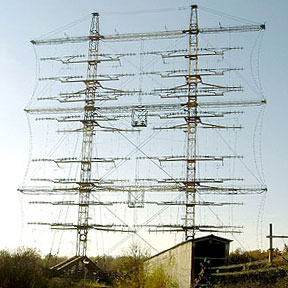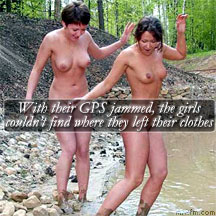Sunday 30 May, 2010, 14:23 - Much Ado About Nothing
Posted by Administrator
Posted by Administrator
 Travelling on the London Underground last week, Wireless Waffle was intrigued by an advertisement for GiffGaff which marketed itself as 'the mobile network run by you'. Visions of self installed cell sites connected back to the network infrastructure by home (or business) broadband connections flashed in front of the eyes. Notions of a new style of organic mobile network where coverage is provided by the users themselves caused a twitch of our technology antennae.
Travelling on the London Underground last week, Wireless Waffle was intrigued by an advertisement for GiffGaff which marketed itself as 'the mobile network run by you'. Visions of self installed cell sites connected back to the network infrastructure by home (or business) broadband connections flashed in front of the eyes. Notions of a new style of organic mobile network where coverage is provided by the users themselves caused a twitch of our technology antennae. Sadly, upon visiting the GiffGaff web-site it turns out to be yet another Mobile Virtual Network Operator (MVNO) like Virgin Mobile, Tesco Mobile and others - and in this case, one which uses O2's mobile network. The 'network run by you' is simply an incentive to get you to get your friends to use GiffGaff SIM cards, a marketing ploy and not a new kind of network at all.
But would it be possible to construct a 'network truly run by you'? Believe it or not, the technology to do this already exists:
Firstly, there are phone handsets which use a WiFi connection to connect to the Internet and then using a suitable service provider, act as extended range cordless phones. They are extended in that if you take them with you to another place where there is a suitable WiFi connection, they log back on to the network and enable you to make and receive calls. Unlike a true mobile service, however, there is no hand-over between WiFi connections meaning that if you move in or out of coverage the call you are making will drop out. But with a WiFi phone you can sit in a coffee shop and make and receive calls as if you were at home - whether or not there is really any value in doing this when you could use an everyday mobile phone is a moot point.
In Japan and some other Asian countries, there is a mobile phone technology known as the Personal Handyphone System (PHS for short) which is technologically similar to the DECT digital cordless phones used in Europe. PHS (and it's 3G variant known as XGP) use short range, cordless phone like base stations which connect back to a central newtork control centre via a standard telecommunications connection (historically an ISDN circuit). The resulting network is similar to that of WiFi phones in that you have a home cordless phone, but which you can take with you to other houses where coverage exists (eg other PHS subscribers). The main difference between PHS and WiFi phones is that there is proper hand-over between cells such that you can walk down a street where there is PHS coverage and continue to make your call. Indeed, by adding a few cell sites at key locations and relying on users to extend coverage by their home connections, reasonably large coverage has been achieved without the operator needing to put expensive cell sites everywhere. One of the main problems of PHS is that cell sizes are relatively small due to the low power nature of the technology, but no smaller than that of a WiFi connection. It is now also rather antiquated technology and it is not clear whether operators will upgrade to XGP or some other technology - PHS subscriber numbers are on the decline.
 More recently there has been a development typified by services such as Vodafone's Sure Signal. These are miniature cell sites known as 'femto cells' which plug into your broadband connection and provide (in this case) 3G coverage in the immediate area. Having a 3G cell site in your house (or office) gets around the problem of coverage blackspots in a big way. Femto cells are fully working parts of the mobile network to which they are connected and therefore you can seamlessly roam in and out of coverage as you leave home (as indeed you can with PHS). 3G femto cells allow you to use your 3G phone or data card at home and in nearby areas.
More recently there has been a development typified by services such as Vodafone's Sure Signal. These are miniature cell sites known as 'femto cells' which plug into your broadband connection and provide (in this case) 3G coverage in the immediate area. Having a 3G cell site in your house (or office) gets around the problem of coverage blackspots in a big way. Femto cells are fully working parts of the mobile network to which they are connected and therefore you can seamlessly roam in and out of coverage as you leave home (as indeed you can with PHS). 3G femto cells allow you to use your 3G phone or data card at home and in nearby areas.Now... imagine a situation where a whole street had installed femto cells such that there was unbroken coverage as you walked or drove along it. There would be no need for coverage provided by any official network operator. In this case all the network coverage would be provided by the users. All that would be required would be some organisation to provide the central functions such as allocating phone numbers and managing mobility (handing over calls between cells) and hey presto! - truly a 'network run by you'. The only thing stopping anyone from launching such a service is lack of (harmonised) radio spectrum. In theory, someone could launch a 'network run by you' in the same, unlicensed spectrum, used by WiFi devices but the handsets they would need would be proprietary and thus expensive. If they could roll-out 3G femto cells instead, the handsets would be available off the shelf. But all of the 3G frequencies have already been assigned to licensed operators who are, in no way, going to allow some upstart to usurp some of their valuable spectrum.
 Which is kind of where organisations such as Google and Microsoft step up to the lectern with their desire to operate 'WiFi 2.0' in spectrum known as whitespace. Whitespace spectrum is that which lives inbetween terrestrial television transmitters but which cannot be used for more television without causing interferenece. It could be used for lower power short-range services though - such as femto cells for example. So combine the idea of femto cells, widely available, licence-free spectrum with big money backers, and perhaps the concept of a network 'run by you' is closer than might have first been apparent.
Which is kind of where organisations such as Google and Microsoft step up to the lectern with their desire to operate 'WiFi 2.0' in spectrum known as whitespace. Whitespace spectrum is that which lives inbetween terrestrial television transmitters but which cannot be used for more television without causing interferenece. It could be used for lower power short-range services though - such as femto cells for example. So combine the idea of femto cells, widely available, licence-free spectrum with big money backers, and perhaps the concept of a network 'run by you' is closer than might have first been apparent.2 comments
( 1041 views )
| permalink
| 



 ( 3.2 / 66015 )
( 3.2 / 66015 )




 ( 3.2 / 66015 )
( 3.2 / 66015 )
Thursday 1 April, 2010, 08:04 - Pirate/Clandestine
Posted by Administrator
Posted by Administrator
 There is endless speculation on the internet as to what became of the many pirate radio ships which sailed the seven seas (or the North Sea more specifically) in the bygone era. Wireless Waffle can exclusively reveal the final resting home of one of these infamous nafarious vessels, having been tipped off by a Government source who wishes to remain anonymous. 'Dave Herrish' for want of a better name (and a complete lack of imagination on our part) has informed us that the rigging that adorned the pirate ship 'The Ross Communidel Amigocado' was removed from the hull at a secret military shipyard somewhere on the southern northern Europe coast and transported, piece by piece, to the facilites of Radio Bulgaria where it was re-assembled and used as a mast for their short-wave monitoring station.
There is endless speculation on the internet as to what became of the many pirate radio ships which sailed the seven seas (or the North Sea more specifically) in the bygone era. Wireless Waffle can exclusively reveal the final resting home of one of these infamous nafarious vessels, having been tipped off by a Government source who wishes to remain anonymous. 'Dave Herrish' for want of a better name (and a complete lack of imagination on our part) has informed us that the rigging that adorned the pirate ship 'The Ross Communidel Amigocado' was removed from the hull at a secret military shipyard somewhere on the southern northern Europe coast and transported, piece by piece, to the facilites of Radio Bulgaria where it was re-assembled and used as a mast for their short-wave monitoring station.Situated between Varna and Dolni Chiflik the antennas are now used as a high gain array for the purposes of intercepting both civil and military radio traffic. But, twice a year, in what must be one of the most ironic celebrations in Europe, the station is opened to the public whereupon bunting and other maritime flags are fastened and festooned to the antennas and small children are allowed to climb up and pretend to be seafaring pirates.
Unbeknownst to many of these children, the Bulgarian phrase for 'I am a pirate', which is 'Лиц ентура дёка ролаян' transliterates as 'lits entura dyohka rolayan' (try saying it out loud), which is often heard being screeched loudly across the countryside accompanied by the ringing of ships bells. Ding dong!
Wednesday 31 March, 2010, 03:11 - Amateur Radio
Posted by Administrator
Having seen this... the following somehow came immediately to mind...Posted by Administrator
It is of course well known that careless talk costs lives, but the full scale of the problem is not always appreciated.
For instance, at the very moment that it was concluded that 'economically speaking, short-wave listening wins hands down' a freak wormhole opened up in the fabric of the quasi-scientific continuum and carried these words far far across almost infinite reaches of space to a distant office where strange and warlike beings were poised on the brink of a frightful regulatory battle.
The two opposing leaders were meeting for the last time.A dreadful silence fell across the conference table as the commander of the RSGB, resplendent with his black jewelled battle antenna, gazed levelly at the Ofcom leader squatting opposite him in a cloud of sweet-smelling spectrum smog, and, with a million sleek and horribly beweaponed lawyers poised to unleash legal hell at his single word of command, challenged the creature to take back what it had said about his latest report on the applicability of EN55022.
The creature stirred in his sickly broiling vapour, and at that very moment the words, 'economically speaking, short-wave listening wins hands down' drifted across the conference table.
Unfortunately, in the Ofcom tongue this was the most dreadful insult imaginable, and there was nothing for it but to wage terrible war.
Eventually, of course, after the bureaucracy in their swish London offices had been decimated, it was realised that the whole thing had been a ghastly mistake, and so the two opposing battle forces settled their few remaining differences in order to launch a joint attack on Comtrend - now positively identified as the source of the original offence.
For thousands more pounds the mighty forces tore across the empty wastes of the Earth and finally dived screaming on to the first factory in China they came across - where due to a terrible miscalculation of emissions the entire battle force was taken to court for breaching the local EMC regulations and locked up in a prison for the ensuing millennia.
Those who study the complex interplay of cause and effect in the history of the the radio spectrum say that this sort of thing is going on all the time, but that we are powerless to prevent it.
'It's just life,' they say.
With respect to Douglas Adams
 First off, let's get a few things straight. GPS works by using a constellation of about 30 medium earth orbit (MEO) satellites run by the US military which go whizzing around the earth twice every day at a height of 20,000 km to transmit position and time information to receivers on the ground. From this information GPS receivers then can work out where they are. This means that the only person who knows your location is you - there is no path back to the satellite which somehow covertly tells the satellite where you are.
First off, let's get a few things straight. GPS works by using a constellation of about 30 medium earth orbit (MEO) satellites run by the US military which go whizzing around the earth twice every day at a height of 20,000 km to transmit position and time information to receivers on the ground. From this information GPS receivers then can work out where they are. This means that the only person who knows your location is you - there is no path back to the satellite which somehow covertly tells the satellite where you are. Thus GPS devices in themselves can not be used to 'track' the location of users. What they do provide is location information which could then be sent on via some other (radio) connection to enable someones location to be tracked. Standard in-car navigation systems do not have such a facility built in and thus using one does not alert the authorities (or anyone else for that matter) to your location.
That aside, there are in increasing number of uses to which GPS is being put in which the location information it provides is used for control purposes. For example, there are anti-social behaviour tags which monitor the location of offenders and send a signal to the local police or council if the person wearing it goes outside a pre-determined area (or indeed goes inside a particular area).
Similarly, knowing where a vehicle is (for example by sending the GPS location back to a central point via a GSM phone) can be used for road toll or car insurance calculation. There is therefore a growing 'demand' for devices which can stop the GPS receiver working so that the location information for tracking people or cars is not available. Such devices are known as GPS jammers and work in much the same way as the jammers used by various governments to stop international broadcasters.
 The most basic GPS jammers operate by producing a high power signal on the main frequency used by GPS receivers, strong enough to ensure that the GPS receiver can no longer hear the (very weak) signals from the GPS satellites and therefore thinks it has lost them and stops working. However, receiver manufacturers have gotten wise to such wheezes and have managed to find ways to overcome this 'carrier' jamming. More sophisticated jammers closely mimic the GPS signal so that not only is the receiver overwhelmed by the local interference but it becomes far more difficult to overcome the jamming as it looks just like a valid GPS signal.
The most basic GPS jammers operate by producing a high power signal on the main frequency used by GPS receivers, strong enough to ensure that the GPS receiver can no longer hear the (very weak) signals from the GPS satellites and therefore thinks it has lost them and stops working. However, receiver manufacturers have gotten wise to such wheezes and have managed to find ways to overcome this 'carrier' jamming. More sophisticated jammers closely mimic the GPS signal so that not only is the receiver overwhelmed by the local interference but it becomes far more difficult to overcome the jamming as it looks just like a valid GPS signal.The problem, though, with such jammers is that they don't just wipe out GPS reception by the receiver they are intending to interrupt, but can knock out GPS reception over quite a wide area. Even basic, low power devices (which typically use transmitter powers of around 10 milliWatts) can produce signals strong enough to stop GPS receivers working over a range of several hundred metres. More powerful devices (and there are some easy to get hold of devices which put out a Watt or more) can cause problems for GPS receivers over ranges of over a mile. So without knowing it, someone trying to defeat the GPS monitoring device put in their company car to monitor their movements can unintentionally end up causing aircraft or ships to not be able to identify where they are either.
Now, of course, GPS jammers are illegal to use as they intentionally cause interference which is not just unlawful in that you generally need a licence for any radio transmitter, but that causing harmful interference is a particularly scandalous deed. The problem of GPS jammers is well recognised by the authorities and the impacts of their use so severe that they are one of the very few devices that organisations such as eBay have been asked to stop the selling of on their web-site (try searching there for 'GPS jammer' and you won't find a single one on offer). However, there are ways and means of getting hold of them and like anything that is useful in a 'getting out of paying for something' or 'getting around the law' way, it's almost certain that their sale will continue with devices popping up from new suppliers as the authorities crack down on sellers one by one.
 Whilst all this might sound a bit like scaremongering, with aircraft falling out of the sky, that's not the real problem (aircraft don't crash just because they lose their GPS signal). Earlier it was mentioned that GPS satellites transmit both position and time information. The time information is used for a very wide range of applications, from synchronising digital transmitter networks, to ensuring that trades on the stock market are correctly time-stamped. Imagine if these timing signals were lost - TV transmitters would fail and the stock market would come crashing down, so no Coronation Street and no hefty bonuses for city workers (whilst the last of these might not seem too severe, losing Coronation Street would be a national crisis).
Whilst all this might sound a bit like scaremongering, with aircraft falling out of the sky, that's not the real problem (aircraft don't crash just because they lose their GPS signal). Earlier it was mentioned that GPS satellites transmit both position and time information. The time information is used for a very wide range of applications, from synchronising digital transmitter networks, to ensuring that trades on the stock market are correctly time-stamped. Imagine if these timing signals were lost - TV transmitters would fail and the stock market would come crashing down, so no Coronation Street and no hefty bonuses for city workers (whilst the last of these might not seem too severe, losing Coronation Street would be a national crisis). GPS jammers have been described as a 'clear and present danger' and much is being done to try and minimise both their availability and their impact, but it seems their use will continue, and most likely continue to grow. If you feel like popping out and buying one for any reason, think again, you might as well drop a teaspoon of polonium-210 in your local neighbourhood resevoir - the consequences of both for society may not be that far apart!


